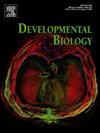Evolutionary conservation of midline repulsive signaling by Robo family receptors in flies and mice
IF 2.1
3区 生物学
Q2 DEVELOPMENTAL BIOLOGY
引用次数: 0
Abstract
The Roundabout (Robo) family is an evolutionarily conserved group of axon guidance receptors that regulate midline crossing in a wide range of animal groups by signaling midline repulsion in response to Slit ligands. However, it is not known whether Robo receptors from different species signal midline repulsion via equivalent mechanisms. To examine the evolutionary conservation of midline repulsive signaling, here we express Robo family proteins from mouse in neurons of the fruit fly, Drosophila melanogaster. We show that Robo proteins which normally function in canonical Slit-dependent midline repulsion in the mouse (mRobo1 and mRobo2) can also repel Drosophila axons from the midline in the fly embryonic ventral nerve cord, and can partially rescue the ectopic midline crossing defects caused by loss of Drosophila robo1, though less efficiently as Drosophila Robo1 itself. In contrast, mouse Robo3 isoforms (mRobo3.1 and mRobo3.2) which do not normally respond to Slit have no detectable effect on axon guidance when expressed in fly embryos. We further show that the differences in midline repulsive signaling effectiveness between fly and mouse Robos is not due to a simple difference in Slit affinity conferred by the Slit-binding Ig1 domain. Together, our results support the idea that the core signaling mechanisms employed by Robo family receptors are conserved across bilaterians, though some degree of evolutionary divergence has decreased the ability of receptors from different bilaterian clades to directly substitute for one another.

果蝇和小鼠Robo家族受体中线排斥信号的进化保护。
Roundabout (Robo)家族是一组进化上保守的轴突引导受体,通过对Slit配体的中线排斥信号来调节中线交叉,在广泛的动物群体中。然而,不知道来自不同物种的机器人受体是否通过等效机制发出中线排斥信号。为了研究中线排斥信号的进化保守性,我们在果蝇的神经元中表达来自小鼠的Robo家族蛋白。我们发现,在小鼠(mRobo1和mRobo2)中,通常在典型的裂缝依赖中线排斥中起作用的Robo蛋白也可以从果蝇胚胎腹侧神经索中线排斥果蝇轴突,并且可以部分地挽救由于果蝇robo1丢失而引起的异位中线交叉缺陷,尽管效率低于果蝇本身。相比之下,小鼠Robo3亚型(mRobo3.1和mRobo3.2)通常不响应Slit,当在果蝇胚胎中表达时,对轴突引导没有可检测到的影响。我们进一步表明,果蝇和小鼠Robos中线排斥信号有效性的差异并不是由于Slit结合Ig1结构域所赋予的Slit亲和力的简单差异。总之,我们的研究结果支持这样的观点,即Robo家族受体采用的核心信号机制在双侧动物中是保守的,尽管某种程度的进化分歧降低了来自不同双侧动物分支的受体直接相互替代的能力。
本文章由计算机程序翻译,如有差异,请以英文原文为准。
求助全文
约1分钟内获得全文
求助全文
来源期刊

Developmental biology
生物-发育生物学
CiteScore
5.30
自引率
3.70%
发文量
182
审稿时长
1.5 months
期刊介绍:
Developmental Biology (DB) publishes original research on mechanisms of development, differentiation, and growth in animals and plants at the molecular, cellular, genetic and evolutionary levels. Areas of particular emphasis include transcriptional control mechanisms, embryonic patterning, cell-cell interactions, growth factors and signal transduction, and regulatory hierarchies in developing plants and animals.
 求助内容:
求助内容: 应助结果提醒方式:
应助结果提醒方式:


